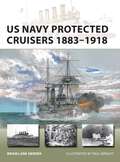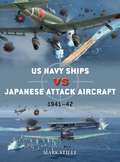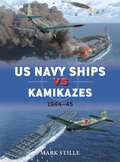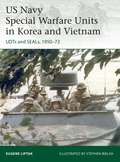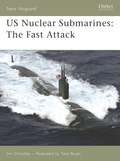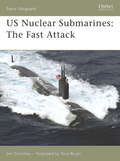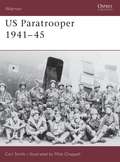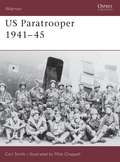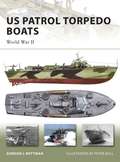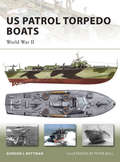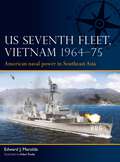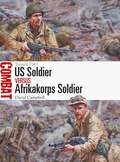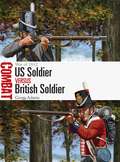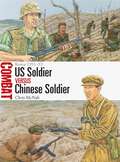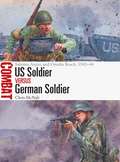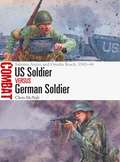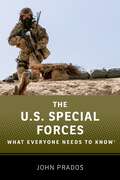- Table View
- List View
US Navy Protected Cruisers 1883–1918 (New Vanguard #320)
by Brian Lane HerderExplores the history of the US Navy's 11 new steel warships, built during the late 19th century to advance American naval supremacy.After the American Civil War, the powerful US Navy was allowed to decay into utter decrepitude, and was becoming a security liability. In 1883, Congress approved four new steel-constructed vessels called the “ABCD” ships. The three protected cruisers Atlanta, Boston, and Chicago were the first steel warships built for the US Navy, whose 1880s–1890s technological and cultural transformation was so total it is now remembered as the “New Navy”. This small fleet was joined by a succession of new and distinctive protected cruisers, culminating in the famous and powerful Olympia. These 11 protected cruisers formed the backbone of the early US steel navy, and were in the frontline of the US victory in the 1898 Spanish-American War. It was these warships that fought and won the decisive Battle of Manila Bay. These cruisers also served faithfully as escorts and auxiliaries in World War I before the last were retired in the 1920s.Written by experienced US naval researcher Brian Lane Herder, and including rare photographs, this book explores the development, qualities, and service of these important warships, and highlights the almost-forgotten Columbia-class, designed as high-speed commerce raiders, and to mimic specific passenger liners. All 11 protected cruisers are depicted in meticulously researched color illustrations with one depicting the Olympia deploying her full sail rig.
US Navy Ships vs Japanese Attack Aircraft: 1941–42 (Duel)
by Mark StilleThe striking power of the Imperial Japanese Navy's carrier-based attack aircraft was established at Pearl Harbor, and the IJN's carrier-based torpedo and dive-bombers showed their prowess again at the Battle of Coral Sea when they sank the US Navy carrier USS Lexington and damaged the carrier USS Yorktown. Even at the disastrous Battle of Midway, the relatively small number of IJNAF attack- and torpedo-bombers that were launched against the US fleet proved that they remained a potent force by heavily damaging Yorktown again, which allowed an IJN submarine to sink the carrier. At Guadalcanal, IJNAF carrier-based aircraft sank the carrier USS Hornet and badly damaged USS Enterprise twice. However, throughout 1942, US Navy ship defences brought down an increasing number of attacking IJNAF aircraft. The final major battle of the year, the Battle of Santa Cruz, exacted crippling losses on the IJN, setting the stage for the eclipse of the IJNAF's highly trained and effective aviation attack forces. Packed with illustrations and contemporary photographs, this engrossing volume details the design, tactics, and operational records of both the US Navy ships and the IJNAF aircraft which attacked them over the year following Pearl Harbor.
US Navy Ships vs Japanese Attack Aircraft: 1941–42 (Duel #105)
by Mark StilleThe striking power of the Imperial Japanese Navy's carrier-based attack aircraft was established at Pearl Harbor, and the IJN's carrier-based torpedo and dive-bombers showed their prowess again at the Battle of Coral Sea when they sank the US Navy carrier USS Lexington and damaged the carrier USS Yorktown. Even at the disastrous Battle of Midway, the relatively small number of IJNAF attack- and torpedo-bombers that were launched against the US fleet proved that they remained a potent force by heavily damaging Yorktown again, which allowed an IJN submarine to sink the carrier. At Guadalcanal, IJNAF carrier-based aircraft sank the carrier USS Hornet and badly damaged USS Enterprise twice. However, throughout 1942, US Navy ship defences brought down an increasing number of attacking IJNAF aircraft. The final major battle of the year, the Battle of Santa Cruz, exacted crippling losses on the IJN, setting the stage for the eclipse of the IJNAF's highly trained and effective aviation attack forces. Packed with illustrations and contemporary photographs, this engrossing volume details the design, tactics, and operational records of both the US Navy ships and the IJNAF aircraft which attacked them over the year following Pearl Harbor.
US Navy Ships vs Kamikazes 1944–45 (Duel)
by Jim Laurier Mark StilleThe ineffectiveness of conventional air attacks on US Navy surface ships, particularly heavily defended targets like carrier task groups, forced the Japanese to re-evaluate their tactics in late 1944. The solution they arrived at was simple – crash their aircraft into American ships. This notion of self-sacrifice fit well within the Japanese warrior psyche and proved terrifying to the American sailors subjected to it. These tactics brought immediate results, and proved effective until the end of the war.This book examines this terrifying new way of waging war, revealing how the US Navy was forced to adapt its tactics and deploy new weapons to counter the threat posed by kamikaze attacks, as well as assessing whether the damage caused to American naval strength by the loss of so many pilots and aircraft actually had a material impact.
US Navy Ships vs Kamikazes 1944–45 (Duel #76)
by Mark StilleThe ineffectiveness of conventional air attacks on US Navy surface ships, particularly heavily defended targets like carrier task groups, forced the Japanese to re-evaluate their tactics in late 1944. The solution they arrived at was simple – crash their aircraft into American ships. This notion of self-sacrifice fit well within the Japanese warrior psyche and proved terrifying to the American sailors subjected to it. These tactics brought immediate results, and proved effective until the end of the war.This book examines this terrifying new way of waging war, revealing how the US Navy was forced to adapt its tactics and deploy new weapons to counter the threat posed by kamikaze attacks, as well as assessing whether the damage caused to American naval strength by the loss of so many pilots and aircraft actually had a material impact.
US Navy Special Warfare Units in Korea and Vietnam: UDTs and SEALs, 1950–73 (Elite)
by Eugene LiptakDuring the Korean War and the Vietnam War, US Navy Special Warfare units played a variety of vital combat roles amid two of the deadliest conflicts of the Cold War. In Korea, underwater demolition teams (UDTs) surveyed beaches for amphibious operations, cleared sea mines from harbors, conducted seaborne raids against inshore targets, and served as scouts for the infiltration of Korean guerrillas and British Royal Marine Commando raids along the North Korean coast. In South Vietnam, UDTs surveyed beaches and demolished Viet Cong bunkers, supply caches, and river obstacles in the Mekong Delta. The SEALs (Sea Air Land teams) deployed entire platoons into the Mekong Delta and the Rung Sat Special Zone to conduct guerrilla warfare against the Viet Cong that included ambushes, reconnaissance, and capturing leaders and supply caches. In addition, the SEALs also played important roles in the Phoenix Program and in rescuing prisoners of war. Fully illustrated throughout, this study explores how the US Navy's specially trained naval commandos accomplished their missions in Korea and Vietnam.
US Navy Special Warfare Units in Korea and Vietnam: UDTs and SEALs, 1950–73 (Elite)
by Eugene LiptakDuring the Korean War and the Vietnam War, US Navy Special Warfare units played a variety of vital combat roles amid two of the deadliest conflicts of the Cold War. In Korea, underwater demolition teams (UDTs) surveyed beaches for amphibious operations, cleared sea mines from harbors, conducted seaborne raids against inshore targets, and served as scouts for the infiltration of Korean guerrillas and British Royal Marine Commando raids along the North Korean coast. In South Vietnam, UDTs surveyed beaches and demolished Viet Cong bunkers, supply caches, and river obstacles in the Mekong Delta. The SEALs (Sea Air Land teams) deployed entire platoons into the Mekong Delta and the Rung Sat Special Zone to conduct guerrilla warfare against the Viet Cong that included ambushes, reconnaissance, and capturing leaders and supply caches. In addition, the SEALs also played important roles in the Phoenix Program and in rescuing prisoners of war. Fully illustrated throughout, this study explores how the US Navy's specially trained naval commandos accomplished their missions in Korea and Vietnam.
US Nuclear Submarines: The Fast Attack (New Vanguard)
by Tony Bryan Jim ChristleyThe adoption of nuclear power revolutionized submarine design and means that vessels can stay underwater for months, trailing the enemy or training weapons on land targets from secret positions, "always there, never seen.†? Jim Christley, a former submariner, explores here the influence of Admiral Hyman Rickover in cautiously introducing these stealthy machines of war, and frankly discusses the power and perils of using nuclear reactors at sea. Using unique and detailed artwork, he outlines the many evolving aspects of design within the submarine classes, from the very first nuclear submarine, USS Nautilus, to the classes under construction even now.
US Nuclear Submarines: The Fast Attack (New Vanguard #138)
by Tony Bryan Jim ChristleyThe adoption of nuclear power revolutionized submarine design and means that vessels can stay underwater for months, trailing the enemy or training weapons on land targets from secret positions, "always there, never seen.†? Jim Christley, a former submariner, explores here the influence of Admiral Hyman Rickover in cautiously introducing these stealthy machines of war, and frankly discusses the power and perils of using nuclear reactors at sea. Using unique and detailed artwork, he outlines the many evolving aspects of design within the submarine classes, from the very first nuclear submarine, USS Nautilus, to the classes under construction even now.
US Paratrooper 1941–45 (Warrior #26)
by Carl Smith Mike ChappellIn Sicily, Normandy, and in the frozen hills of the Ardennes, America's airborne warriors proved themselves some of the toughest and most determined soldiers of World War 2. What made these soldiers so special? How were they recruited, how did they learn to jump and fight? What special tactics and equipment did they use? This title looks at what it was like to be one of the United States' airborne elite, through the experiences of the soldiers themselves. It is the story of the men who invariably led the way; the soldiers who flew to battle and walked home.
US Paratrooper 1941–45 (Warrior #26)
by Carl Smith Mike ChappellIn Sicily, Normandy, and in the frozen hills of the Ardennes, America's airborne warriors proved themselves some of the toughest and most determined soldiers of World War 2. What made these soldiers so special? How were they recruited, how did they learn to jump and fight? What special tactics and equipment did they use? This title looks at what it was like to be one of the United States' airborne elite, through the experiences of the soldiers themselves. It is the story of the men who invariably led the way; the soldiers who flew to battle and walked home.
US Patrol Torpedo Boats: World War II (New Vanguard)
by Peter Bull Gordon L. RottmanMotor torpedo boat development began in the early 1900s, and the vessels first saw service during World War I. However, it was not until the late 1930s that the US Navy commenced the development of the Patrol Torpedo or PT boat. The PT boat was designed for attacking larger warships with torpedoes using its 'stealth' ability, high-speed and small size to launch and survive these attacks – although they were employed in a wide variety of other missions, including rescuing General MacArthur and his entourage from the Philippines. This book examines the design and development of these unique craft, very few of which survive today, and goes on to examine their role and combat deployment in World War II.
US Patrol Torpedo Boats: World War II (New Vanguard #148)
by Gordon L. RottmanALSO AVAILABLE AS AN E-BOOK. Motor torpedo boat development began in the early 1900s, and the vessels first saw service during World War I. However, it was not until the late 1930s that the US Navy commenced the development of the Patrol Torpedo or PT boat. The PT boat was designed for attacking larger warships with torpedoes using its 'stealth' ability, high-speed and small size to launch and survive these attacks – although they were employed in a wide variety of other missions, including rescuing General MacArthur and his entourage from the Philippines. This book examines the design and development of these unique craft, very few of which survive today, and goes on to examine their role and combat deployment in World War II.
US Seventh Fleet, Vietnam 1964–75: American naval power in Southeast Asia (Fleet #4)
by Edward J. Marolda"This is a terrific history of the Seventh Fleet's vital service to the United States in the Vietnam War... remarkably researched and interpreted"- Admiral Jonathan W. Greenert, Chief of Naval Operations, 2011–2015 and Commander Seventh Fleet, 2004–2006"Combines a crisp text by the leading authority on the subject, with well-chosen contemporary photographs, new maps, and excellent art work… an excellent introduction to a complex conflict, and the operational lessons learnt."- Professor Andrew Lambert, Laughton Professor of Naval History, King's College LondonA superbly illustrated examination of how the US Navy's most powerful fleet fought the Vietnam War, covering all of its elements from aircraft carriers and heavy cruisers to minesweepers and oilers.The US Navy's Seventh Fleet was at the forefront of America's campaign in Vietnam for a decade, from the Gulf of Tonkin Incident that began it all to the final evacuation of South Vietnam. Its mission was highly strategic, and while its primary role was to provide carrier-based air power over North Vietnam – from Rolling Thunder through Linebacker – the fleet's operations were complex, sensitive, and varied, and required all the capabilities of the fleet.This book is the first overall examination of how US Navy's most powerful fleet fought and operated in Vietnam. Distilled from thousands of declassified secret documents by renowned US Navy specialist Dr Edward J. Marolda, it offers a unique new portrait of how the Seventh Fleet fought the Vietnam War, from the offensive strike power of naval aviation to the vital role of fleet logistics. As well as the carrier operations, he examines the surface combatant fleet's gunfire support role, and its raids against the North Vietnamese coast. Dr Marolda also looks at amphibious warfare, fleet air defense, search-and-rescue, and mining and interdiction operations. Illustrated throughout with archive photos, 3D diagrams and spectacular new artwork, and informed by never-before-translated official documents, publications, and personal accounts from North Vietnamese, Soviet, and Chinese sources, this is the real story behind the US Navy's Vietnam War.
US Seventh Fleet, Vietnam 1964–75: American naval power in Southeast Asia (Fleet #4)
by Edward J. Marolda"This is a terrific history of the Seventh Fleet's vital service to the United States in the Vietnam War... remarkably researched and interpreted"- Admiral Jonathan W. Greenert, Chief of Naval Operations, 2011–2015 and Commander Seventh Fleet, 2004–2006"Combines a crisp text by the leading authority on the subject, with well-chosen contemporary photographs, new maps, and excellent art work… an excellent introduction to a complex conflict, and the operational lessons learnt."- Professor Andrew Lambert, Laughton Professor of Naval History, King's College LondonA superbly illustrated examination of how the US Navy's most powerful fleet fought the Vietnam War, covering all of its elements from aircraft carriers and heavy cruisers to minesweepers and oilers.The US Navy's Seventh Fleet was at the forefront of America's campaign in Vietnam for a decade, from the Gulf of Tonkin Incident that began it all to the final evacuation of South Vietnam. Its mission was highly strategic, and while its primary role was to provide carrier-based air power over North Vietnam – from Rolling Thunder through Linebacker – the fleet's operations were complex, sensitive, and varied, and required all the capabilities of the fleet.This book is the first overall examination of how US Navy's most powerful fleet fought and operated in Vietnam. Distilled from thousands of declassified secret documents by renowned US Navy specialist Dr Edward J. Marolda, it offers a unique new portrait of how the Seventh Fleet fought the Vietnam War, from the offensive strike power of naval aviation to the vital role of fleet logistics. As well as the carrier operations, he examines the surface combatant fleet's gunfire support role, and its raids against the North Vietnamese coast. Dr Marolda also looks at amphibious warfare, fleet air defense, search-and-rescue, and mining and interdiction operations. Illustrated throughout with archive photos, 3D diagrams and spectacular new artwork, and informed by never-before-translated official documents, publications, and personal accounts from North Vietnamese, Soviet, and Chinese sources, this is the real story behind the US Navy's Vietnam War.
US Soldier vs Afrikakorps Soldier: Tunisia 1943 (Combat)
by David CampbellOperation Torch, launched on 8 November 1942, landed Anglo-American forces in Vichy-controlled Morocco and Algeria to create a second front against the Axis forces in North Africa, catching Rommel's German and Italian forces in the claws of a giant pincer. The US Army was powerfully well armoured and equipped, but fresh to war, and it showed. Organization suffered from a surfeit of peacetime theories and training was insufficient and ill-applied. Despite such failings the US GIs and their commanders learned very quickly, adapting to German tactics and the realities of mechanized warfare. The Axis forces in North Africa were seasoned by years of fighting against increasingly powerful British and Commonwealth forces, and were led by one of the Reich's most capable generals. The German doctrine of mechanized warfare had proved itself time and again, but ever-growing logistical and supply problems were blunting its effectiveness. From Sidi Bou Zid to El Guettar, this fully illustrated study pits the US Army against the best that the Axis forces in Africa had to offer.
US Soldier vs Afrikakorps Soldier: Tunisia 1943 (Combat)
by David CampbellOperation Torch, launched on 8 November 1942, landed Anglo-American forces in Vichy-controlled Morocco and Algeria to create a second front against the Axis forces in North Africa, catching Rommel's German and Italian forces in the claws of a giant pincer. The US Army was powerfully well armoured and equipped, but fresh to war, and it showed. Organization suffered from a surfeit of peacetime theories and training was insufficient and ill-applied. Despite such failings the US GIs and their commanders learned very quickly, adapting to German tactics and the realities of mechanized warfare. The Axis forces in North Africa were seasoned by years of fighting against increasingly powerful British and Commonwealth forces, and were led by one of the Reich's most capable generals. The German doctrine of mechanized warfare had proved itself time and again, but ever-growing logistical and supply problems were blunting its effectiveness. From Sidi Bou Zid to El Guettar, this fully illustrated study pits the US Army against the best that the Axis forces in Africa had to offer.
US Soldier vs British Soldier: War of 1812 (Combat)
by Gregg AdamsBetween June 1812 and January 1815, US and British forces, notably the regular infantrymen of both sides (including the Canadian Fencibles Regiment), fought one another on a host of North American battlefields. This study examines the evolving role and combat performance of the two sides' regulars during the conflict, with particular reference to three revealing battles in successive years: Queenston Heights, Crysler's Farm, and Chippawa.Featuring full-color artwork and battle maps, this fully illustrated study investigates the US and British regular infantry's role, tactics, junior leadership, and combat performance on three battlefields of the War of 1812. The actions assessed here notably demonstrate the evolution of US regulars from their initial poor showing to an emerging professionalism that allowed them to face their British opponents on equal terms.
US Soldier vs British Soldier: War of 1812 (Combat)
by Gregg AdamsBetween June 1812 and January 1815, US and British forces, notably the regular infantrymen of both sides (including the Canadian Fencibles Regiment), fought one another on a host of North American battlefields. This study examines the evolving role and combat performance of the two sides' regulars during the conflict, with particular reference to three revealing battles in successive years: Queenston Heights, Crysler's Farm, and Chippawa.Featuring full-color artwork and battle maps, this fully illustrated study investigates the US and British regular infantry's role, tactics, junior leadership, and combat performance on three battlefields of the War of 1812. The actions assessed here notably demonstrate the evolution of US regulars from their initial poor showing to an emerging professionalism that allowed them to face their British opponents on equal terms.
US Soldier vs Chinese Soldier: Korea 1951–53 (Combat)
by Chris McNabThis book examines the US infantry against the Chinese Army amid the unforgiving terrain of Korea during the first real clash of the Cold War.On June 25, 1950, North Korean troops invaded South Korea, triggering a bitter conflict that drew in US and other United Nations forces in support of the South, and soon prompted the Chinese to intervene on the side of the North. Featuring specially commissioned artwork, this study assesses the US and Chinese forces that clashed at Chipyongni (February 13–15, 1951), Triangle Hill (October 14–25, 1952), and Pork Chop Hill (July 6–11, 1953), casting light on the origins, doctrine, and combat effectiveness of these two very different forces during the struggle for victory in Korea. The Chinese forces fighting in Korea were composed of experienced, confident soldiers buoyed by the Communists' success in the recent Chinese Civil War. Initially armed and equipped with much the same weaponry and doctrine that they had employed in World War II, US Army units in Korea would often find themselves outnumbered, fighting in extremely difficult terrain that precluded the widespread use of armor. Both sides would be tested to the limit by the demands of fighting in such a formidable setting.
US Soldier vs Chinese Soldier: Korea 1951–53 (Combat)
by Chris McNabThis book examines the US infantry against the Chinese Army amid the unforgiving terrain of Korea during the first real clash of the Cold War.On June 25, 1950, North Korean troops invaded South Korea, triggering a bitter conflict that drew in US and other United Nations forces in support of the South, and soon prompted the Chinese to intervene on the side of the North. Featuring specially commissioned artwork, this study assesses the US and Chinese forces that clashed at Chipyongni (February 13–15, 1951), Triangle Hill (October 14–25, 1952), and Pork Chop Hill (July 6–11, 1953), casting light on the origins, doctrine, and combat effectiveness of these two very different forces during the struggle for victory in Korea. The Chinese forces fighting in Korea were composed of experienced, confident soldiers buoyed by the Communists' success in the recent Chinese Civil War. Initially armed and equipped with much the same weaponry and doctrine that they had employed in World War II, US Army units in Korea would often find themselves outnumbered, fighting in extremely difficult terrain that precluded the widespread use of armor. Both sides would be tested to the limit by the demands of fighting in such a formidable setting.
US Soldier vs German Soldier: Salerno, Anzio, and Omaha Beach, 1943–44 (Combat)
by Chris McNabDuring World War II, the US Army and its allies faced a formidable challenge: the need to assault Hitler's 'Fortress Europe' from the sea. As a result, during 1941–45, the US Army had to add amphibious assault to its list of combat capabilities. Officers and troops from across the US Armed Forces had to develop the techniques and technologies to assault the coasts of Axis-occupied Europe, from logistics to beach assault and beachhead consolidation, and more. In order to win and hold a contested beachhead in the face of bitter enemy resistance, the amphibious-warfare specialists played a variety of essential battlefield roles; if the US troops could not establish a beachhead quickly, they risked being thrown back into the sea. For their part, the Germans had to devise a practical defensive doctrine that made the most of the limited resources and troops available and the terrain. The German infantry defenders immediately around the landing areas had to be able to call upon support from nearby artillery, mechanized troops, and armoured forces to have a chance of containing the enemy beachhead. This illustrated study analyses the specialist beach-landing troops involved in three key battles – the Allied amphibious landings at Salerno and Anzio in Italy, and Omaha Beach in Normandy – focusing upon the US Army's various types of beach-assault specialists and their German opponents, whose combat experience and effectiveness varied considerably. Each of the three featured battles is then examined in detail, exploring how the Germans made defensive preparations; how the US troops planned to overcome them; and the immediate actions undertaken by the US amphibious specialists and their German opponents both during and following the main assault landings.
US Soldier vs German Soldier: Salerno, Anzio, and Omaha Beach, 1943–44 (Combat #48)
by Chris McNabDuring World War II, the US Army and its allies faced a formidable challenge: the need to assault Hitler's 'Fortress Europe' from the sea. As a result, during 1941–45, the US Army had to add amphibious assault to its list of combat capabilities. Officers and troops from across the US Armed Forces had to develop the techniques and technologies to assault the coasts of Axis-occupied Europe, from logistics to beach assault and beachhead consolidation, and more. In order to win and hold a contested beachhead in the face of bitter enemy resistance, the amphibious-warfare specialists played a variety of essential battlefield roles; if the US troops could not establish a beachhead quickly, they risked being thrown back into the sea. For their part, the Germans had to devise a practical defensive doctrine that made the most of the limited resources and troops available and the terrain. The German infantry defenders immediately around the landing areas had to be able to call upon support from nearby artillery, mechanized troops, and armoured forces to have a chance of containing the enemy beachhead. This illustrated study analyses the specialist beach-landing troops involved in three key battles – the Allied amphibious landings at Salerno and Anzio in Italy, and Omaha Beach in Normandy – focusing upon the US Army's various types of beach-assault specialists and their German opponents, whose combat experience and effectiveness varied considerably. Each of the three featured battles is then examined in detail, exploring how the Germans made defensive preparations; how the US troops planned to overcome them; and the immediate actions undertaken by the US amphibious specialists and their German opponents both during and following the main assault landings.
The US Special Forces: What Everyone Needs to Know® (What Everyone Needs To Know®)
by John PradosThe assassination of Osama bin Laden by SEAL Team 6 in May 2011 will certainly figure among the greatest achievements of US Special Forces. After nearly ten years of searching, they descended into his Pakistan compound in the middle of the night, killed him, and secreted the body back into Afghanistan. Interest in these forces had always been high, but it spiked to new levels following this success. There was a larger lesson here too. For serious jobs, the president invariably turns to the US Special Forces: the SEALs, Delta Force, the Green Berets, and the USAF's Special Tactics squad. Given that secretive grab-and-snatch operations in remote locales characterize contemporary warfare as much as traditional firefights, the Special Forces now fill a central role in American military strategy and tactics. Not surprisingly, the daring and secretive nature of these commando operations has generated a great deal of interest. The American public has an overwhelmingly favorable view of the forces, and nations around the world recognize them as the most capable fighting units: the tip of the American spear, so to speak. But how much do we know about them? What are their origins? What function do they fill in the larger military structure? Who can become a member? What do trainees have to go through? What sort of missions do Special Forces perform, and what are they expected to accomplish? Despite their importance, much of what they do remains a mystery because their operations are clandestine and the sources elusive. In The US Special Forces: What Everyone Needs to Know, eminent scholar John Prados brings his deep expertise to the subject and provides a pithy primer on the various components of America's special forces. The US military has long employed Special Forces in some form or another, but it was in the Cold War when they assumed their present form, and in Vietnam where they achieved critical mass. Interestingly, the Special Forces suffered a rapid decline in numbers after that conflict despite the fact that the United States had already identified terrorism as a growing security threat. The revival of Special Forces began under the Reagan administration. After 9/11 they experienced explosive growth, and are now integral to all US military missions. Prados traces how this happened and examines the various roles the Special Forces now play. They have taken over many functions of the regular military, a trend that Prados does not expect will end any time soon. This will be a definitive primer on the elite units in the most powerful military the world has ever known.
The US Special Forces: What Everyone Needs to Know® (What Everyone Needs To Know®)
by John PradosThe assassination of Osama bin Laden by SEAL Team 6 in May 2011 will certainly figure among the greatest achievements of US Special Forces. After nearly ten years of searching, they descended into his Pakistan compound in the middle of the night, killed him, and secreted the body back into Afghanistan. Interest in these forces had always been high, but it spiked to new levels following this success. There was a larger lesson here too. For serious jobs, the president invariably turns to the US Special Forces: the SEALs, Delta Force, the Green Berets, and the USAF's Special Tactics squad. Given that secretive grab-and-snatch operations in remote locales characterize contemporary warfare as much as traditional firefights, the Special Forces now fill a central role in American military strategy and tactics. Not surprisingly, the daring and secretive nature of these commando operations has generated a great deal of interest. The American public has an overwhelmingly favorable view of the forces, and nations around the world recognize them as the most capable fighting units: the tip of the American spear, so to speak. But how much do we know about them? What are their origins? What function do they fill in the larger military structure? Who can become a member? What do trainees have to go through? What sort of missions do Special Forces perform, and what are they expected to accomplish? Despite their importance, much of what they do remains a mystery because their operations are clandestine and the sources elusive. In The US Special Forces: What Everyone Needs to Know, eminent scholar John Prados brings his deep expertise to the subject and provides a pithy primer on the various components of America's special forces. The US military has long employed Special Forces in some form or another, but it was in the Cold War when they assumed their present form, and in Vietnam where they achieved critical mass. Interestingly, the Special Forces suffered a rapid decline in numbers after that conflict despite the fact that the United States had already identified terrorism as a growing security threat. The revival of Special Forces began under the Reagan administration. After 9/11 they experienced explosive growth, and are now integral to all US military missions. Prados traces how this happened and examines the various roles the Special Forces now play. They have taken over many functions of the regular military, a trend that Prados does not expect will end any time soon. This will be a definitive primer on the elite units in the most powerful military the world has ever known.
